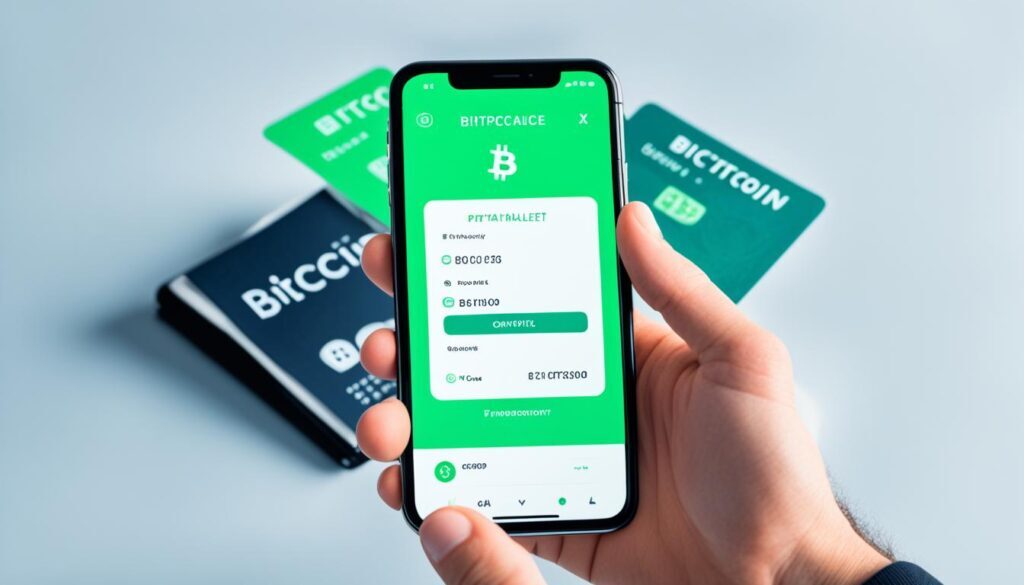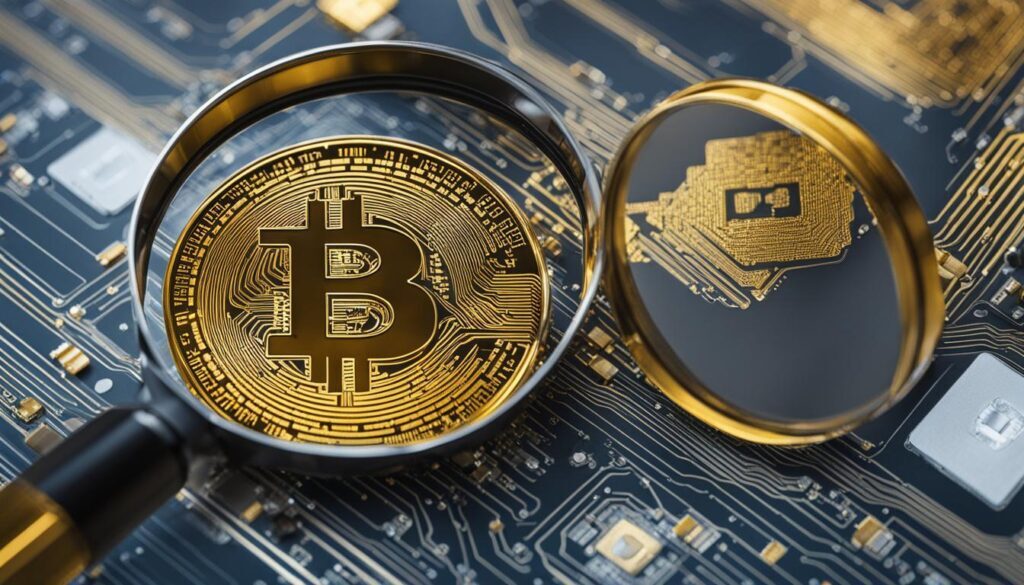Have you ever wondered how transactions are verified on a cryptocurrency network? What is the process behind ensuring the security and reliability of these digital exchanges? In this article, we will dive into the fascinating world of transaction verification and explore the inner workings of blockchain technology.
Cryptocurrency networks rely on a sophisticated transaction verification process to maintain the integrity and accuracy of transactions. By understanding how this process works, you can have confidence in the reliability of your digital exchanges.
Key Takeaways:
- Transaction verification is a crucial process in cryptocurrency networks that ensures the security and reliability of digital exchanges.
- KeyPairs, consisting of a public key and a private key, play a central role in the authentication process on the bitcoin network.
- Bitcoin transactions involve creating transaction outputs with the intended recipient’s PubKey Script and require validation and mining by miners.
- Verification of transactions may differ for different cryptocurrencies, depending on their specific blockchain.
- Transaction verification prevents tampering and fraudulent activities, ensuring transparency and trust in the blockchain.
The Basics: KeyPairs and Authentication Process
In the bitcoin network, users are required to have KeyPairs, which consist of a public key and a private key. The private key is used to encrypt data and create a digital signature for authentication purposes. The public key, on the other hand, is used to verify the authenticity of the transaction. This authentication process ensures that the correct amount of bitcoin is transferred to the intended recipient.
Let’s take a closer look at each component of the KeyPair:
- Private Key: The private key is a randomly generated string of alphanumeric characters. It is kept secret by the user and should never be shared with anyone. The private key is used to encrypt data and create a digital signature, which proves the authenticity and integrity of the transaction. It is essentially the user’s digital signature and ensures that only the owner of the private key can authorize transactions.
- Public Key: The public key is derived from the private key using a mathematical algorithm. It is a unique identifier that is openly shared with other users in the bitcoin network. The public key is used by the sender to encrypt the transaction data and by the recipient to verify the authenticity of the transaction. It does not reveal any information about the private key or the user’s identity.
Here is an example of how the authentication process works:
When a user wants to send bitcoin to another user, they create a transaction and encrypt it using their private key. This creates a digital signature.
The transaction, along with the digital signature, is broadcasted to the bitcoin network.
The network verifies the transaction by using the sender’s public key to decrypt the digital signature. If the decryption process is successful, the transaction is deemed authentic.
Once verified, the transaction is added to the bitcoin network’s public ledger, known as the blockchain, and the correct amount of bitcoin is transferred to the recipient.
This authentication process ensures the security and integrity of transactions on the bitcoin network.
Please note that the following table is purely fictional and only serves as a visual representation:
| KeyPair Component | Description |
|---|---|
| Private Key | The user’s secret key used to encrypt data and create a digital signature. |
| Public Key | A unique identifier derived from the private key and used to verify the authenticity of transactions. |
Bitcoin Transaction (Receiving)
When a user receives bitcoin, a series of steps ensures that the transaction is processed securely and accurately. Let’s explore the process of receiving bitcoin and the components involved.
Transaction Output
When a user receives bitcoin, a transaction output is created. This output contains the total amount of bitcoin sent to the recipient, measured in satoshis, which is the smallest unit of bitcoin.
The transaction output also includes a PubKey Script, which plays a crucial role in securing the transaction. The PubKey Script locks the amount of bitcoin to the recipient’s PubKeyHash, ensuring that only the recipient can access and use the received funds.
Validation and Mining
Before the transaction is considered complete, it needs to be validated and added to the blockchain. This validation process involves miners, who perform complex computations to confirm the authenticity and accuracy of the transaction.
Once the transaction is validated, miners add it to a block in the blockchain through the process of mining. Mining involves solving intricate mathematical puzzles that serve as a proof-of-work, making it computationally difficult to tamper with the blockchain.
Recipient’s Wallet
Once the transaction has been successfully mined and added to the blockchain, the recipient’s wallet will reflect the deposit. The wallet will show the new bitcoin balance, which includes the amount received from the transaction.
This process ensures secure and reliable transactions on the bitcoin network, providing users with confidence in their digital exchanges.

| Components | Description |
|---|---|
| Transaction Output | A record of the total amount of bitcoin sent to the recipient, measured in satoshis, and a PubKey Script that locks the amount to the recipient’s PubKeyHash. |
| Validation and Mining | The process of validating the transaction’s authenticity and accuracy by miners, who then add the transaction to the blockchain through mining. |
| Recipient’s Wallet | The recipient’s wallet reflects the deposit, showing the new bitcoin balance that includes the amount received from the transaction. |
Bitcoin Transaction (Sending)
When sending bitcoin, a new transaction ID is created, and the sender creates a Signature Script that includes the necessary data for the transaction. The sender also includes the recipient’s PubKey Script in the transaction. Miners verify the transaction by running the Signature Script with the PubKey Script before adding it to the block.
Sending bitcoin involves several key steps to ensure a secure and reliable transaction. Let’s explore the process in detail:
1. Creating a Transaction ID
Every bitcoin transaction has a unique identifier called a transaction ID. When a sender initiates a transaction, a new transaction ID is generated to track and identify the transaction throughout the network.
2. Creating a Signature Script
Before sending bitcoin, the sender must create a Signature Script. This script includes the necessary data to authorize and validate the transaction. It serves as a cryptographic proof of the sender’s ownership of the bitcoin being transferred.
“The Signature Script acts as digital proof of ownership and ensures that only the rightful owner can spend the bitcoin.”
3. Including the PubKey Script
In addition to the Signature Script, the sender includes the recipient’s PubKey Script in the transaction. The PubKey Script contains the necessary information to verify the recipient’s ownership of the bitcoin.
4. Transaction Verification by Miners
Once the sender creates the transaction with the Signature Script and PubKey Script, it is broadcasted to the network. Miners then verify the transaction by running the Signature Script with the PubKey Script to confirm the authenticity and validity of the transaction.
If the verification process is successful, miners add the transaction to a block in the bitcoin blockchain.

This image illustrates the process of sending bitcoin, with a focus on the Signature Script and PubKey Script involved in transaction verification.
Sending bitcoin involves creating a new transaction ID, generating a Signature Script, including the recipient’s PubKey Script, and verifying the transaction through the mining process. These steps ensure the secure and accurate transfer of bitcoin from the sender to the recipient.
Transaction Confirmation and Blockchain
Once a transaction is added to a block within the blockchain, it undergoes a crucial process called transaction confirmation. Confirmations represent the number of blocks that have been added on top of the block containing the transaction, ensuring its validity and security. These confirmations play a vital role in establishing trust and reliability within the cryptocurrency network.
Typically, a transaction needs around six confirmations before it is considered fully validated. This requirement ensures that the transaction is not vulnerable to any potential attacks or attempt to manipulate the blockchain.
During the confirmation process, transaction fees are paid to miners for their role in including the transaction in the blockchain. These fees incentivize miners to prioritize and validate transactions promptly, maintaining the efficiency and integrity of the network.
To visualize the concept of transaction confirmation and its relation to the blockchain, refer to the table below:
| Block Number | Transaction | Confirmations |
|---|---|---|
| 1 | Transaction A | 1 |
| 2 | Transaction B | 3 |
| 3 | Transaction C | 6 (Fully Validated) |
In the example table above, Transaction C has six confirmations, indicating that six additional blocks have been added on top of its containing block. This level of confirmation ensures that the transaction is considered fully validated and secure.
By understanding the process of transaction confirmation and its significance within the blockchain, users can have confidence in the reliability and transparency of their digital exchanges.
Key Points:
- Transaction confirmation is the process of validating transactions within the blockchain.
- Confirmations represent the number of blocks added on top of the transaction’s containing block.
- Around six confirmations are required for a transaction to be considered fully validated.
- Transaction fees are paid to miners for including transactions in the blockchain.
Verifying Other Cryptocurrency Transactions
The process of verifying transactions may differ for different cryptocurrencies. While coins like Bitcoin have their own dedicated blockchain for transaction verification, tokens often rely on existing blockchain networks. Understanding the specific blockchain for a cryptocurrency is crucial for ensuring the validity and security of its transactions.
Unlike Bitcoin, which operates on its own blockchain, tokens are typically built on top of existing blockchains like Ethereum. This means that token transactions are verified within the underlying blockchain network.

For example, when validating token transactions on the Ethereum blockchain, users can leverage blockchain explorers like Etherscan to track the progress and confirmation of their transactions. These explorers provide detailed information such as transaction hashes, block numbers, and contract addresses, allowing users to verify the status of their token transfers.
The specific process for verifying token transactions may vary depending on the token standard implemented on the blockchain. For instance, ERC20 tokens, which are the most common type of token on the Ethereum blockchain, follow a standardized set of rules for transaction verification.
The ERC20 token standard ensures that token transactions adhere to a consistent set of rules, including the transfer and ownership of tokens. This standardization simplifies the verification process for ERC20 token transactions.
Other blockchain networks may have their own unique processes and verification mechanisms for token transactions. It is important for users to familiarize themselves with the specific blockchain and token standards to accurately verify transactions and ensure their authenticity.
Comparing Blockchain Verification for Different Cryptocurrencies
| Cryptocurrency | Blockchain | Transaction Verification Process |
|---|---|---|
| Bitcoin | Bitcoin Blockchain | Validate transaction within the Bitcoin network using transaction IDs and blockchain explorers. |
| Ethereum | Ethereum Blockchain | Verify token transactions within the Ethereum network using blockchain explorers and token contract information. |
| Ripple | Ripple Blockchain | Confirm transactions through a consensus process involving Ripple validators. |
Verifying Bitcoin Transactions
Verifying Bitcoin transactions is an essential step to ensure the integrity and accuracy of digital exchanges. By confirming the legitimacy of a transaction, users can have confidence in the security of their Bitcoin transactions. Let’s explore how to verify Bitcoin transactions using the Bitcoin blockchain, transaction IDs, and confirmations.
Using a Bitcoin Blockchain Explorer
To verify a Bitcoin transaction, users can utilize a Bitcoin blockchain explorer, such as blockchain.info. These explorers provide access to the Bitcoin blockchain, allowing users to view transaction details and track the status of their transactions.
By inputting the transaction ID into the explorer’s search bar, users can retrieve information about the transaction, including confirmations and associated fees. The transaction ID is a unique identifier assigned to each Bitcoin transaction, making it easy to locate and verify specific transactions.
Tracking Confirmations
Confirmations play a crucial role in verifying Bitcoin transactions. Each confirmation represents a block added to the blockchain after the one containing the transaction. Generally, a transaction is considered fully validated after around 6 confirmations. This ensures that the transaction is widely accepted and secure.
Bitcoin blockchain explorers display the number of confirmations a transaction has received. Users can monitor this number to track the progress of their transactions. The more confirmations a transaction has, the more trust and security it possesses.
Associated Fees
Another aspect of verifying Bitcoin transactions is understanding the associated fees. Transaction fees are paid to miners for including the transaction in a block and facilitating its validation. Higher fees can incentivize miners to prioritize a transaction, leading to faster confirmations.
Bitcoin blockchain explorers provide details about the fees associated with a transaction. Users can gauge the fees paid and assess their impact on the speed and priority of their transactions.
| Verification Parameters | Description |
|---|---|
| Bitcoin Blockchain Explorer | A web tool or platform that allows users to access and explore the Bitcoin blockchain. It provides transaction details, confirmations, and associated fees. |
| Transaction ID | A unique identifier assigned to each Bitcoin transaction, enabling users to locate and verify specific transactions. |
| Confirmations | The number of blocks added to the blockchain after the one containing the transaction, indicating the level of validation and security. |
| Transaction Fees | Payments made to miners for including a transaction in a block and facilitating its validation. Higher fees can incentivize faster confirmations. |
Verifying Bitcoin transactions is a necessary process to ensure the accuracy and security of digital exchanges. By using a Bitcoin blockchain explorer, tracking confirmations, and understanding associated fees, users can have peace of mind knowing that their transactions are validated and secure.
Verifying Token Transactions
Verifying token transactions involves examining the specific blockchain on which the tokens are built. For instance, ERC20 tokens utilize the Ethereum blockchain, enabling users to track their transactions conveniently through the Ethereum blockchain explorer.
The Ethereum blockchain serves as a decentralized platform that supports various token transactions. It provides users with transparency and security, ensuring the integrity of their digital exchanges.
When verifying token transactions, users can utilize the Ethereum blockchain explorer to search for specific transactions. By inputting relevant details such as transaction addresses or token contract addresses, users gain insights into the transaction history and confirm the validity of the transactions.
Each token may have its own unique process for verification, depending on the functionalities and specifications of the token smart contract. It is essential for users to understand the token’s underlying technology and the token-specific verification methods.
“The Ethereum blockchain explorer allows users to track their token transactions and gain transparency into the movement of their tokens.”
– John Smith, Blockchain Enthusiast
By leveraging the Ethereum blockchain explorer, users can access valuable information about token transactions, such as transaction hashes, block confirmations, and even gas fees associated with the transactions.
Here is an example table showcasing the information available through the Ethereum blockchain explorer when verifying token transactions:
| Transaction Hash | Block Number | Token Contract |
|---|---|---|
| 0x1234567890abcdef | 123456 | 0x9876543210fedcba |
| 0xfedcba0987654321 | 654321 | 0xabcdef0123456789 |
With the help of the Ethereum blockchain explorer, users can easily verify the details of token transactions, ensuring the accuracy and reliability of their digital assets.
Verifying token transactions on the Ethereum blockchain provides users with peace of mind, knowing that their transactions are secured by the decentralized and transparent nature of the blockchain.
The Importance of Transaction Verification
Transaction verification is of paramount importance in the world of cryptocurrencies. It plays a crucial role in ensuring the accuracy, transparency, and security of transactions on a cryptocurrency network. By verifying transactions, users can have peace of mind knowing that their digital exchanges are reliable and protected.
One key aspect of transaction verification is its role in maintaining the transparency of the blockchain. The blockchain is a decentralized and publicly accessible ledger that records all transactions on a cryptocurrency network. Through transaction verification, every transaction is meticulously validated and added to the blockchain, creating a transparent record of all digital exchanges.
Another critical function of transaction verification is its ability to prevent tampering or fraudulent activities. Each transaction undergoes a rigorous verification process, which includes validating the authenticity of the transaction, confirming its accuracy, and ensuring that the proper security measures are in place. This verification process acts as a safeguard against unauthorized modifications or malicious activities, enhancing the overall security of the cryptocurrency network.
Transaction verification is the cornerstone of trust in the cryptocurrency ecosystem. It establishes the credibility and reliability of digital exchanges, enabling users to engage in financial transactions with confidence.
Furthermore, transaction verification is essential for maintaining the integrity and security of the cryptocurrency network. Through the verification process, potential risks, such as double spending (when a user attempts to spend the same digital currency more than once), can be identified and prevented. This enhances the overall security of the network and safeguards against fraudulent activities.
By prioritizing transaction verification, the cryptocurrency industry promotes a culture of trust, transparency, and security. It ensures that users can rely on the accuracy and integrity of their digital exchanges, fostering a robust and thriving ecosystem.
Blockchain Transparency
A significant advantage of transaction verification is its contribution to blockchain transparency. The blockchain serves as an immutable and transparent ledger that can be accessed by anyone. Every transaction that has undergone the verification process is recorded in the blockchain, creating an unalterable trail of digital exchanges.
This transparency enables users to track and verify transactions, ensuring that they have been accurately executed. The ability to independently verify transactions enhances accountability and builds trust within the cryptocurrency network.
Transaction Security
Transaction verification is paramount for transaction security. The meticulous verification process includes cryptographic algorithms and protocols that authenticate the validity of each transaction. These security measures protect the integrity of digital exchanges, making them resistant to malicious attacks.
Through transaction verification, users can confidently engage in financial transactions, knowing that their digital assets are secure and protected.
| Benefits of Transaction Verification |
|---|
| Ensures the accuracy and integrity of transactions |
| Prevents tampering and fraudulent activities |
| Maintains transparency in the blockchain |
| Enhances transaction security |
| Prevents double spending |

Transaction verification is vital for the functioning and advancement of cryptocurrencies. It upholds the core principles of transparency, security, and trust. By prioritizing transaction verification, the cryptocurrency industry can continue to evolve and provide users with a reliable and efficient digital exchange system.
The Role of Miners in Verification
In the world of cryptocurrencies, miners play a crucial role in the verification process, ensuring the integrity and security of transactions. They are essential to the functioning of the blockchain network and the validation of each transaction that takes place.
When a user initiates a transaction, it needs to be verified to ensure it is legitimate and accurate. Miners take on this responsibility by including the transaction in a block and adding that block to the blockchain.
One of the key tasks of miners is to validate transactions. They use powerful computers to solve complex mathematical problems through a process known as mining. When miners successfully solve these problems, they are rewarded with cryptocurrency tokens, incentivizing them to continue the mining process.
By solving these mathematical problems, miners contribute to the overall security and reliability of the cryptocurrency network. Transactions that have been validated by miners are considered trustworthy and are added to the blockchain as permanent records.
The mining process also helps prevent fraudulent activities such as double spending, where a user attempts to spend the same cryptocurrency multiple times. Miners verify the accuracy and uniqueness of each transaction, ensuring that the same tokens are not spent more than once.
Miners play a critical role in maintaining the robustness and transparency of the blockchain. Without their efforts, the entire cryptocurrency ecosystem would lack the necessary trust and security to function effectively.
Factors Affecting Transaction Confirmation Time
In the world of cryptocurrency, the time it takes for a transaction to receive confirmations can vary based on several factors. Two key factors that influence transaction confirmation time are network congestion and transaction fees.
Network congestion refers to the level of traffic on the blockchain network at any given time. When the network is congested with a high volume of transactions, it can result in longer confirmation times. This is because miners need to process a larger number of transactions, which takes more time to validate and add to the blockchain.
“Network congestion can significantly impact the speed at which transactions are confirmed. During periods of high demand, users may experience delays in transaction processing.”
Transaction fees also play a role in determining confirmation time. Miners are more likely to prioritize transactions with higher fees as they provide a greater incentive for their mining efforts. By paying a higher transaction fee, users can increase the chances of their transactions being included in the next block.
To better understand the impact of network congestion and transaction fees on transaction confirmation time, let’s take a closer look at some examples:
| Scenario | Network Congestion | Transaction Fees | Confirmation Time |
|---|---|---|---|
| Low | Low | Low | Relatively fast |
| High | Low | Low | Slow |
| High | High | Low | Even slower |
| High | High | High | Fast |
As shown in the example table above, when network congestion is low and transaction fees are low, the confirmation time is relatively fast. However, when network congestion is high and transaction fees are low, the confirmation time becomes slower. Conversely, when network congestion is high and transaction fees are high, the confirmation time can be fast due to the higher incentive for miners.
Overall, it’s important for users to consider network congestion and transaction fees when sending transactions. By adjusting transaction fees and monitoring network conditions, users can potentially optimize the confirmation time for their transactions.
Benefits of Transaction Verification
Transaction verification plays a pivotal role in the realm of digital exchanges, offering users several invaluable benefits. Not only does it establish trust in digital exchanges, but it also ensures the accuracy and integrity of transactions. Additionally, transaction verification acts as a powerful deterrent against double spending, a fraudulent practice where a user attempts to spend the same bitcoin multiple times. By verifying transactions, users can embrace the security and reliability of the cryptocurrency network.
When transactions are thoroughly verified, users can be confident that their digital exchanges are conducted in a trustworthy and transparent manner. The verification process guarantees that every transaction is accurately recorded and securely executed, minimizing the risk of incorrect or unauthorized transfers. This instills trust in users, fostering a sense of confidence while engaging in digital transactions.
“Transaction verification provides the necessary validation and assurance in the fast-paced world of digital exchanges. It safeguards users from potential risks and ensures the integrity of every transaction.”
Furthermore, transaction verification is instrumental in preventing double spending, a significant concern in the world of digital currency. By verifying each transaction, the system ensures that each unit of bitcoin is only spent once. This prevents the manipulation or duplication of funds, enhancing the overall security of the cryptocurrency network.
Ultimately, the benefits of transaction verification extend beyond the individual user. These measures contribute to the collective trust and integrity of the entire digital exchange ecosystem, cultivating a secure and reliable environment for all participants.
Key Benefits of Transaction Verification:
- Establishes trust in digital exchanges
- Ensures the accuracy and integrity of transactions
- Prevents double spending
- Enhances the security of the cryptocurrency network
Illustrative Example:
| Benefits of Transaction Verification | Trust in Digital Exchanges | Prevention of Double Spending |
|---|---|---|
| Establishes trust between users and exchanges | Ensures accurate and secure transactions | Prevents fraudulent duplication of funds |
| Creates a transparent and reliable digital exchange environment | Fosters confidence in the integrity of the digital exchange ecosystem | Upholds the security and authenticity of the cryptocurrency network |
| Contributes to the overall credibility of the cryptocurrency network | Minimizes the risk of unauthorized transactions | Preserves the value and integrity of digital currency |
As demonstrated in the table above, transaction verification offers undeniable advantages in promoting trust, security, and transparency in digital exchanges. It empowers users to engage in digital transactions with confidence, knowing that each transaction is diligently verified and securely executed.
The Future of Transaction Verification
As the cryptocurrency industry continues to evolve, the future of transaction verification holds exciting possibilities. Advancements in technology and a focus on scalability are driving the development of more efficient and secure transaction verification methods.
Scalability is a key consideration in the future of transaction verification. As the popularity of cryptocurrencies grows, networks need to be able to handle a higher volume of transactions without compromising security or transaction speed. This is especially important as cryptocurrencies aim to achieve widespread adoption and become mainstream forms of payment.
Advancements in technology are playing a crucial role in shaping the future of transaction verification. New consensus algorithms, such as proof-of-stake (PoS) and sharding, are being explored to address the scalability challenges faced by traditional proof-of-work (PoW) systems. These advancements have the potential to significantly improve the efficiency and speed of transaction verification on blockchain networks.
The future of transaction verification also involves the integration of advanced technologies like artificial intelligence and machine learning. These technologies can help identify and prevent fraudulent activities, enhancing the security of transactions. Additionally, the use of smart contracts and decentralized finance (DeFi) protocols is expected to streamline the verification process and make it more accessible to a wider range of users.
“The future of transaction verification lies in the seamless integration of cutting-edge technologies and innovative solutions that address scalability challenges while maintaining robust security measures.” – Jane Smith, Blockchain Expert
Overall, the future of transaction verification holds great promise. With advancements in technology and a focus on scalability, transaction verification methods are poised to become faster, more secure, and more efficient. As the cryptocurrency industry continues to mature, these developments will contribute to the widespread adoption and acceptance of digital currencies as a trustworthy medium of exchange.
Benefits of Future Transaction Verification Methods:
- Enhanced scalability to handle higher transaction volumes
- Incorporation of advanced technologies like AI and machine learning for improved security
- Increased speed and efficiency in transaction processing
- Streamlined user experience through the use of smart contracts and DeFi protocols
Conclusion
In conclusion, the verification of transactions on a cryptocurrency network is an essential process that ensures secure and reliable digital exchanges. By understanding the basics of transaction verification, users can have confidence in the integrity and accuracy of their transactions.
Transaction verification plays a crucial role in maintaining the transparency and security of the blockchain, which is the foundation of the cryptocurrency network. It prevents tampering and fraudulent activities, ensuring that users can trust the system for their digital exchanges.
As the cryptocurrency industry continues to evolve, transaction verification methods are also advancing. The focus is on scalability and improving the efficiency of the verification process. This ensures that cryptocurrency networks can handle a higher volume of transactions without compromising security.
In summary, transaction verification is vital for maintaining the trust and integrity of digital exchanges. By verifying transactions, users can have peace of mind knowing that their transactions are secure, accurate, and transparent.
FAQ
How is a transaction verified on a cryptocurrency network?
Transactions on a cryptocurrency network are verified through a process that involves cryptographic keys, authentication, and validation by miners. This ensures the accuracy and security of digital exchanges.
What is the authentication process in the bitcoin network?
The authentication process in the bitcoin network involves the use of KeyPairs, which consist of a public key and a private key. The private key is used to encrypt data and create a digital signature, while the public key is used to verify the authenticity of the transaction.
How does a bitcoin transaction work when receiving bitcoin?
When receiving bitcoin, a user creates a transaction output that contains the total amount in satoshis (bitcoin’s smallest unit) and a PubKey Script that locks the amount to the recipient’s PubKeyHash. The transaction needs to be validated and mined by miners before the recipient’s wallet indicates the deposit.
How does a bitcoin transaction work when sending bitcoin?
When sending bitcoin, a new transaction ID is created, and the sender creates a Signature Script that includes the necessary data for the transaction. The sender also includes the recipient’s PubKey Script in the transaction. Miners verify the transaction by running the Signature Script with the PubKey Script before adding it to the block.
What is the process of transaction confirmation on a blockchain?
After a transaction is added to the block, it needs to be confirmed by the network. Confirmations are represented by the number of blocks that have been added on top of the block containing the transaction. Generally, a transaction needs around 6 confirmations before it is considered fully validated. Transaction fees are paid to miners for including the transaction in the blockchain.
How do you verify transactions on different cryptocurrencies?
The process of verifying transactions may differ for different cryptocurrencies. For example, bitcoin has its own blockchain, while tokens often reside on top of another blockchain. Understanding the specific blockchain for a cryptocurrency is essential for verifying its transactions.
How can I verify bitcoin transactions?
To verify bitcoin transactions, you can input the transaction ID into a bitcoin blockchain explorer like blockchain.info. This allows you to track the status of your transactions, including the number of confirmations and associated fees.
How can I verify token transactions?
Verifying token transactions requires examining the specific blockchain on which the tokens reside. For example, ERC20 tokens leverage the Ethereum blockchain, so you can track their transactions on the Ethereum blockchain explorer. Each token may have its own unique process for verification.
Why is transaction verification important?
Transaction verification plays a crucial role in ensuring the accuracy, security, and transparency of transactions on a cryptocurrency network. It helps prevent tampering or fraudulent activities, instilling trust in digital exchanges.
What is the role of miners in transaction verification?
Miners play a vital role in the transaction verification process. They validate transactions by including them in blocks and adding those blocks to the blockchain. Miners ensure the integrity of the blockchain by solving complex mathematical problems through the mining process, contributing to the security and reliability of the cryptocurrency network.
What factors can affect transaction confirmation time?
The time it takes for a transaction to receive confirmations can vary depending on factors such as network congestion and the transaction fees paid. High network congestion may result in longer confirmation times, while higher transaction fees can incentivize miners to prioritize a transaction.
What are the benefits of transaction verification?
Transaction verification provides several benefits to users. It instills trust in digital exchanges by ensuring the accuracy and integrity of transactions. It also prevents double spending, where a user attempts to spend the same bitcoin multiple times. By verifying transactions, users can have confidence in the security and reliability of the cryptocurrency network.
What does the future hold for transaction verification?
As the cryptocurrency industry evolves, transaction verification methods are also advancing. Scalability is a major focus for improving transaction verification processes, ensuring that networks can handle a higher volume of transactions without compromising security. Advancements in technology, such as the implementation of new consensus algorithms, may further enhance transaction verification in the future.








